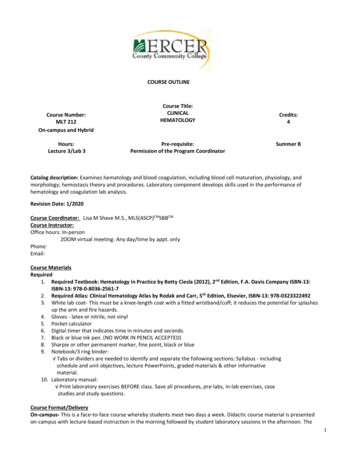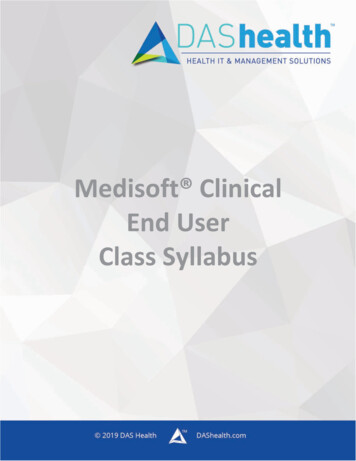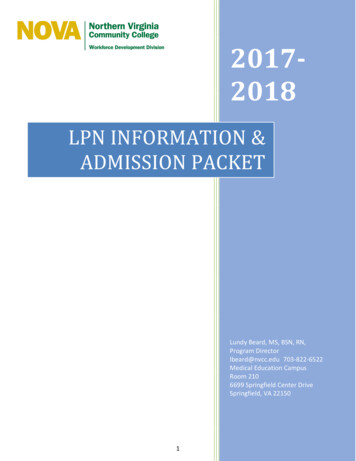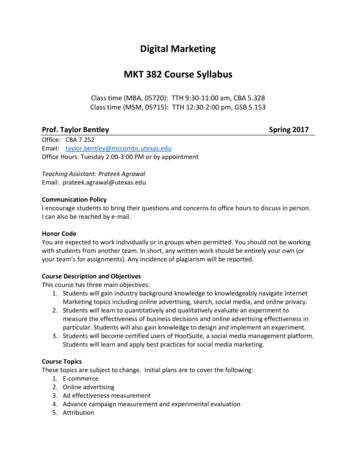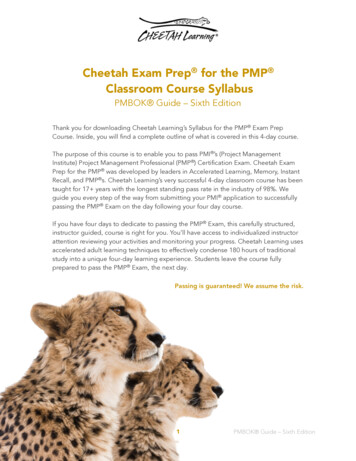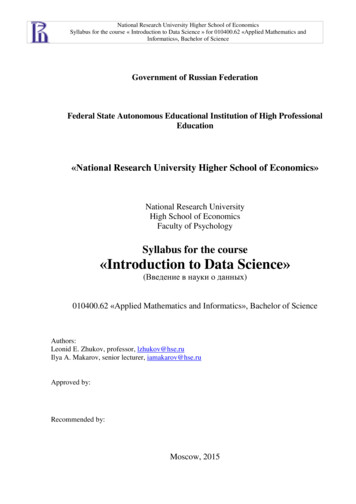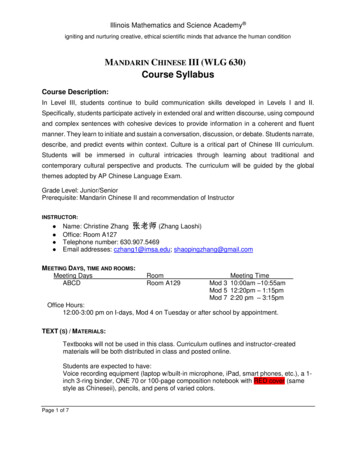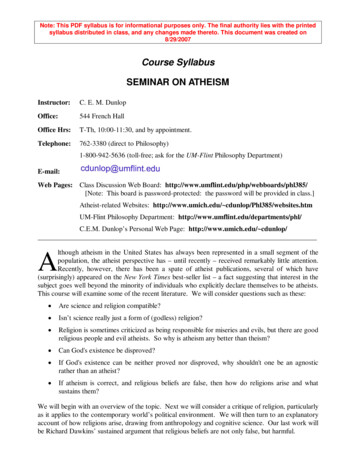
Transcription
Course SyllabusMDCA 1360 – Clinical- Medical/Clinical AssistantCatalog Description: A health-related work-based learning experience that enables the student to applyspecialized occupational theory, skills, and concepts. Direct supervision is provided by the clinicalprofessional.Lecture hours 1, Lab hours 8Prerequisites: MDCA 1310, MDCA 1321Semester Credit Hours: 3Lecture Hours per Week: 1Lab Hours per Week: 8Extended Hours: 0Contact Hours per Semester: 144State Approval Code: CIP 51.0801Instructional Goals and Purposes:The purpose of this course is to prepare students for basic Medical Office Procedures used by a MedicalAssistant in a medical office or clinic setting.Learning Outcomes:After studying all materials and resources presented in the course, the student will be able to:1. Apply the theory, concepts, and skills involving specialized materials, tools, equipment,procedures, regulations, laws, and interactions within and among political, economic,environmental, social and legal systems associated with the occupation and thebusiness/industry.2. Demonstrate legal and ethical behavior, safety practices, interpersonal and teamwork skills, andappropriate written and verbal communication skills using the terminology of the occupation andthe business/industry.Course Content:A general description of lecture/discussion topics included in this course are listed in the LearningObjectives section of this syllabus.Students in all sections of this course will learn the following content:1. Perform the skills listed on the competency evaluation with a minimum of 70% at a satisfactorylevel (SCANS II ciii, II civ, II eii)Preceptors will give an “S” for Satisfactory achievement or an “N” for needs improvement. An“NA” will be given for skills not observed.A student may be given two (2) opportunities to score an “S” on the Skill.
Performance Objectives/Competencies Evaluations:1. *Attends all assigned clinical hours (shows up on time and reports topreceptor before leaving)2. Appears in professional attire at all times3. *Behaves in a professional manner at all times (verbal and nonverbal)4. Accepts supervision and works effectively with staff5. Contributes to a positive work environment6. *Recognizes and Responds to Verbal Communications7. *Performs Within Ethical Boundaries8. *Performs Within Legal Boundaries9. Demonstrates Knowledge of Federal and State Health CareLegislation and Regulations10. Utilizes Computer Software to Maintain Office Systems11. Demonstrates Telephone Techniques: Answer the Telephone andtake a message12. Schedule and Manage Appointments13. Schedule and Manage Appointments: New Patients14. *Establish and Maintain the Medical Record: Organize a Patient’sMedical Record15. Establish and Maintain the Medical Record: Register a New Patient16. Explain General Office PoliciesCheck off date/preceptor’s initials
17. Instruct Individuals According to Their Needs18. Perform an Inventory of Supplies and Equipment19. Locate Resources and Information for Patients and Employers20. Identify Community Resources21. Respond to and Initiate Written Communications: Process IncomingMail22. Establish and Maintain the Medical Record: Prepare an InformedConsent for Treatment Form23. Establish and Maintain the Medical Record: Add SupplementaryItems to Established Patient Records24. Establish and Maintain the Medical Record: Prepare a RecordRelease Form25. *Document Appropriately and Accurately26. Identify and Respond to Issues of Confidentiality27. Explain General Office Policies: Explain Professional Fees28. Post Entries on a Day sheet29. Post Adjustments30. Process a Credit Balance31. Process Refunds32. Observe Accounts Receivable Procedures33. Observe Billing Procedures34. Observe Collection Procedures
35. Observe Collection Agency Payments36. Observe Writing Checks in Payment of Bills37. Observe Preparing a Bank Deposit38. Observe Accounting for Petty CashTotal:/Out of 38* Students who do not pass basic core objectives with satisfactory will not pass the course.TOTAL CLINICAL HOURS: 144 Clinical Orientation 16 clinical hours Service Learning 24 clinical hours (16 hours for preparation/presentation and 8 hours on site) Clinical Site 104 clinical hoursMethods of Instruction/Course Format/Delivery:This course is offered in an ambulatory/clinic setting with an assigned preceptor to further aid the studentin learning and applying administrative skills.Students should use the Email within Canvas to communicate with the instructor. Using Canvas emailgives you access to the instructor and other classmates without having to remember or type emailaddresses - you must select a name from the list. If you are not able to contact me using email in Canvas,you may use my Panola College email address, contact me by telephone, or stop by my office. I attemptto respond to all email within 24 hours. Please always include a subject line and your name in your email.Major Assignments / Assessments:The following items will be assigned and assessed during the semester and used to calculate thestudent’s final grade.Assignments1.2.3.4.5.6.Service Learning ProjectProfessionalismSimulated or actual skills performed in a clinical settingRead CMAA Study Guide (6 Chapters) over the semester (self-paced)CMAA online Practice ExamsCMAA Certification Exam registrationAssessment(s):
1.2.3.4.Clinical Evaluation of skills (scored by preceptor)Service Learning Presentation evaluationProfessionalism evaluationCMAA Practice Exam(s) ScoresCourse Grade:The grading scale for this course is as follows: Simulated or actual skills performed in clinical rotation – 60%Service Learning Project/Presentation -- 30%Professionalism -- 10%CMAA Certification Exam registration required to pass this courseTexts, Materials, and Supplies: Books/materials from first year of Medical Assisting courses CMAA Study Guide atialliedhealth/NHA (printed version) Practice Exams online NHAnow.comRequired Readings:Certified Medical Administrative Assistant (CMAA) Study Guide 2.0Recommended Readings: MA Notes (F.A. Davis) Comprehensive Medical Assisting 5th editionOther: For current texts and materials, use the following link to access bookstore listings:http://www.panolacollegestore.com For testing services, use the following link: http://www.panola.edu/elearning/testing.html If any student in this class has special classroom or testing needs because of a physical learningor emotional condition, please contact the ADA Student Coordinator in Support Services locatedin the Administration Building or go to upportservices/ for more information. Withdrawing from a course is the student’s responsibility. Students who do not attend class andwho do not withdraw will receive the grade earned for the course. Student Handbook, The Pathfinder: hfinder.pdf
SCANS CRITERIA1) Foundation skills are defined in three areas: basic skills, thinking skills, and personalqualities.a) Basic Skills: A worker must read, write, perform arithmetic and mathematical operations, listen,and speak effectively. These skills include:i) Reading: locate, understand, and interpret written information in prose and in documentssuch as manuals, graphs, and schedules.ii) Writing: communicate thoughts, ideas, information, and messages in writing, and createdocuments such as letters, directions, manuals, reports, graphs, and flow charts.iii) Arithmetic and Mathematical Operations: perform basic computations and approach practicalproblems by choosing appropriately from a variety of mathematical techniques.iv) Listening: receive, attend to, interpret, and respond to verbal messages and other cues.v) Speaking: Organize ideas and communicate orally.b) Thinking Skills: A worker must think creatively, make decisions, solve problems, visualize, knowhow to learn, and reason effectively. These skills include:i) Creative Thinking: generate new ideas.ii) Decision Making: specify goals and constraints, generate alternatives, consider risks, andevaluate and choose the best alternative.iii) Problem Solving: recognize problems and devise and implement plan of action.iv) Visualize ("Seeing Things in the Mind's Eye"): organize and process symbols, pictures,graphs, objects, and other information.v) Knowing How to Learn: use efficient learning techniques to acquire and apply new knowledgeand skills.vi) Reasoning: discover a rule or principle underlying the relationship between two or moreobjects and apply it when solving a problem.c) Personal Qualities: A worker must display responsibility, self-esteem, sociability, selfmanagement, integrity, and honesty.i) Responsibility: exert a high level of effort and persevere toward goal attainment.ii) Self-Esteem: believe in one's own self-worth and maintain a positive view of oneself.iii) Sociability: demonstrate understanding, friendliness, adaptability, empathy, and politeness ingroup settings.iv) Self-Management: assess oneself accurately, set personal goals, monitor progress, andexhibit self-control.v) Integrity and Honesty: choose ethical courses of action.2) Workplace competencies are defined in five areas: resources, interpersonal skills,information, systems, and technology.a) Resources: A worker must identify, organize, plan, and allocate resources effectively.i) Time: select goal-relevant activities, rank them, allocate time, and prepare and followschedules.ii) Money: Use or prepare budgets, make forecasts, keep records, and make adjustments tomeet objectives.iii) Material and Facilities: Acquire, store, allocate, and use materials or space efficiently.Examples: construct a decision time line chart; use computer software to plan a project; prepare abudget; conduct a cost/benefits analysis; design an RFP process; write a job description; developa staffing plan.
b) Interpersonal Skills: A worker must work with others effectively.i) Participate as a Member of a Team: contribute to group effort.ii) Teach Others New Skills.iii) Serve Clients/Customers: work to satisfy customer's expectations.iv) Exercise Leadership: communicate ideas to justify position, persuade and convince others,responsibly challenge existing procedures and policies.v) Negotiate: work toward agreements involving exchange of resources, resolve divergentinterests.vi) Work with Diversity: work well with men and women from diverse backgrounds.Examples: collaborate with a group member to solve a problem; work through a group conflictsituation, train a colleague; deal with a dissatisfied customer in person; select and useappropriate leadership styles; use effective delegation techniques; conduct an individual or teamnegotiation; demonstrate an understanding of how people from different cultural backgroundsmight behave in various situations.c) Information: A worker must be able to acquire and use information.i) Acquire and Evaluate Information.ii) Organize and Maintain Information.iii) Interpret and Communicate Information.iv) Use Computers to Process Information.Examples: research and collect data from various sources; develop a form to collect data;develop an inventory record-keeping system; produce a report using graphics; make an oralpresentation using various media; use on-line computer data bases to research a report; use acomputer spreadsheet to develop a budget.d) Systems: A worker must understand complex interrelationships.i) Understand Systems: know how social, organizational, and technological systems work andoperate effectively with them.ii) Monitor and Correct Performance: distinguish trends, predict impacts on system operations,diagnose deviations in systems' performance and correct malfunctions.iii) Improve or Design Systems: suggest modifications to existing systems and develop new oralternative systems to improve performance.Examples: draw and interpret an organizational chart; develop a monitoring process; choose asituation needing improvement, break it down, examine it, propose an improvement, andimplement it.e) Technology: A worker must be able to work with a variety of technologies.i) Select Technology: choose procedures, tools or equipment including computers and relatedtechnologies.ii) Apply Technologies to Task: understand overall intent and proper procedures for setup andoperation of equipment.iii) Maintain and Troubleshoot Equipment: Prevent, identify, or solve problems with equipment,including computers and other technologies.Examples: read equipment descriptions and technical specifications to select equipment to meetneeds; set up and assemble appropriate equipment from instructions; read and follow directionsfor troubleshooting and repairing equipment.
Course Syllabus MDCA 1360 – Clinical- Medical/Clinical Assistant Catalog Description: A health-related work-based learning experience that enables the student to apply specialized occupational theory, skills, and
